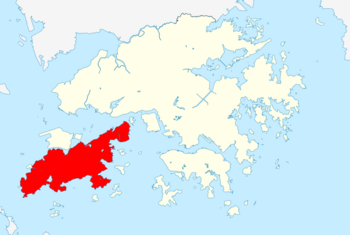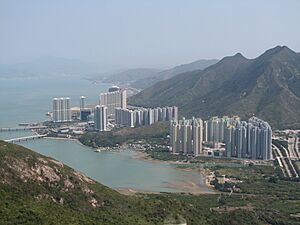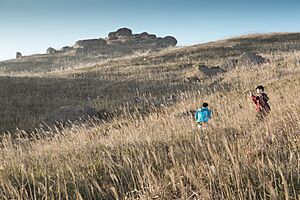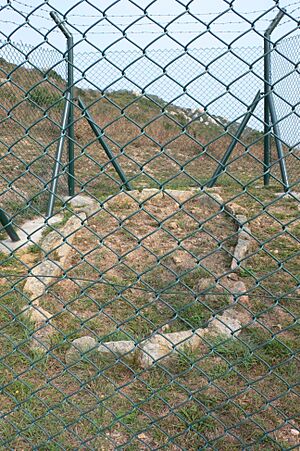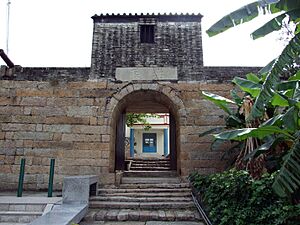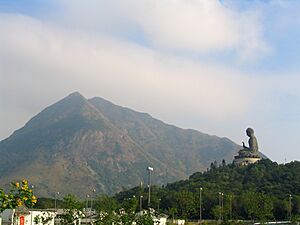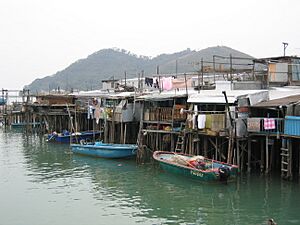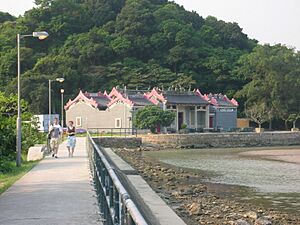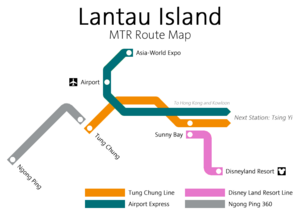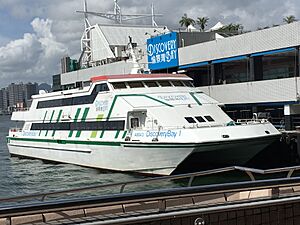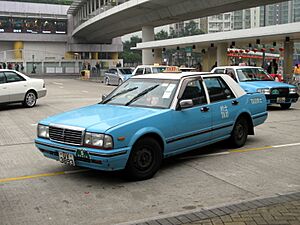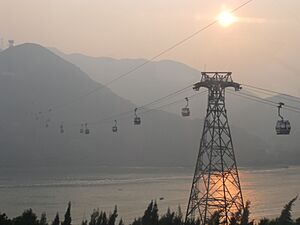Lantau Island facts for kids
| Lantau Island | |||||||||||||||||
|---|---|---|---|---|---|---|---|---|---|---|---|---|---|---|---|---|---|
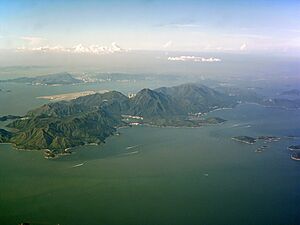
Overall view of Lantau Island, seen from the southeast
|
|||||||||||||||||
| Traditional Chinese | 大嶼山 | ||||||||||||||||
| Simplified Chinese | 大屿山 | ||||||||||||||||
| Literal meaning | "big island mountain" | ||||||||||||||||
|
|||||||||||||||||
Lantau Island is the largest island in Hong Kong. It is located west of Hong Kong Island and the Kowloon Peninsula. Most of Lantau Island is part of the Islands District of Hong Kong. A small part in the northeast belongs to the Tsuen Wan District.
Lantau Island was once home to quiet fishing villages. Since the late 1900s, it has grown a lot. New projects like Tung Chung New Town, Hong Kong International Airport, Hong Kong Disneyland, and Ngong Ping 360 have changed the island.
Contents
- Exploring Lantau Island's Geography
- Understanding Lantau's Population
- The Name of Lantau Island
- Lantau Island's Rich History
- Top Tourist Attractions on Lantau Island
- Lantau's Amazing Plants and Animals
- Getting Around Lantau Island
- Learning on Lantau Island
- Future Plans for Lantau Island
- Famous places
- See also
Exploring Lantau Island's Geography
Lantau is Hong Kong's biggest island, covering about 147 square kilometers. This makes it almost twice the size of Hong Kong Island. The island is mostly covered by mountains. Lantau Peak is the highest point on the island, reaching 934 meters. It is the second highest mountain in all of Hong Kong.
People often call Lantau Island "the lungs of Hong Kong." This is because it has many native forests and not many tall buildings. In contrast, Hong Kong Island and Kowloon have lots of skyscrapers. More than half of Lantau Island is covered by country parks. These include Lantau South Country Park and Lantau North Country Park.
Shek Pik Reservoir is the third largest freshwater reservoir in Hong Kong. It was finished in 1963 and holds about 24.5 million cubic meters of water.
Understanding Lantau's Population
Lantau Island does not have a very high population density. People live in different areas across the island, and each place has its own special feel. When the Hong Kong International Airport opened in 1998, the northwest part of Lantau grew quickly.
- Tung Chung: This quiet village became a new town. It is now home to over 45,000 people. They live in tall apartment buildings near the airport. The nearby Yat Tung Estate houses many people in public housing.
- Discovery Bay: This is a private community on the southeast coast. It has over 20,000 residents from many different countries. It is known for being a place where many people from other countries live.
- Other Villages: Other smaller communities include Mui Wo, Tai O, Tong Fuk, and Pui O.
The Name of Lantau Island
The name Lantau Island comes from an old local name for Lantau Peak. Its Chinese name, Chinese: 大嶼山, means "big island mountain." The island has also been known by other names throughout history, like Tai Hai Shan and Tuen Mun Island.
Lantau Island's Rich History
People have lived on Lantau Island for a very long time. Old items found here include rock carvings from the Bronze Age. There is also a stone circle at Fan Lau from the Neolithic Age.
In 1276, the Southern Song dynasty royal family came to Lantau Island by boat. They were escaping from invaders. Later, the island became an important trading spot for Europeans.
In the early 16th century, there were nine villages on the island. After a period when people were forced to leave, five villages were settled again in 1669. These included Tai O and Mui Wo.
Lantau was a place where pirates and smugglers hid in the 1800s. It was also a base for people fighting against the Japanese during World War II. The island's forests and valleys helped the resistance movement.
In 2000, Lantau Island became an important hub for internet cables. These cables connect Hong Kong to the rest of the world.
Top Tourist Attractions on Lantau Island
Ngong Ping: Home of the Giant Buddha
The Ngong Ping Plateau is a famous spot. Here you can find the Po Lin Monastery and its vegetarian restaurant. It is also home to the Tian Tan Buddha statue, also known as the "Giant Buddha." This huge bronze statue is 26 meters tall. You can hike up to the monastery or take a 25-minute ride on the Ngong Ping 360 cable car from Tung Chung. The cable car ride is 5.7 kilometers long and offers amazing views.
Tai O: A Historic Fishing Village
Tai O is a fishing village in northwest Lantau that is over 300 years old. Visitors love to see its unique stilt houses, called pang uk. Even though some houses have been repaired, Tai O still feels very historic. You can see waterways, fishing boats, and enjoy the mountain scenery. It's also a great place to find traditional Chinese foods like salted fish and shrimp paste.
Tung Chung Fort: A Glimpse into the Past
Tung Chung Fort was built in 1817 to protect the coast from pirates. It has six old cannons and walls made of granite. The Japanese army used the fort during World War II. Today, it is a protected historical monument.
Trappist Haven Monastery: A Peaceful Retreat
The Trappist Haven Monastery is a home for Roman Catholic monks. It is located on the east coast of Lantau Island, between Mui Wo and Discovery Bay.
Hong Kong Disneyland: A Magical Adventure
Hong Kong Disneyland is in the northeast part of the island. It opened on September 12, 2005. This huge project includes a Disney theme park, three hotels, and many shops and restaurants. It even has its own train line from Sunny Bay MTR station.
Nature's Beauty: Hiking and Beaches
Over half of Lantau Island is made up of national parks with many hiking trails. The most famous is the 70-kilometer Lantau Trail. This trail has 12 sections and beautiful natural stone steps. Lantau's longest beach is Cheung Sha. One of the most popular hikes is to Sunset Peak, which is the third highest peak in Hong Kong.
Lantau's Amazing Plants and Animals
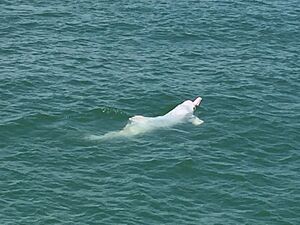
You might see Chinese white dolphins, also known as pink dolphins, off the coast of Lantau. A marine park is being planned to help protect these special animals. In the southern parts of Lantau, people grow oysters, lemons, and tangerines. You can also find wild water buffalos living in Mui Wo and Pui O. The southern part of Lantau Island has a very healthy natural environment.
Getting Around Lantau Island
Airport Connections
Hong Kong International Airport is located on Chek Lap Kok island, just off Lantau's north coast. It opened in 1998. The airport is connected to the city by the Lantau Link, which includes large bridges like the Tsing Ma Bridge.
Train Travel
You can reach the airport by the MTR's Airport Express train. The journey from Central to the airport takes about 23 minutes. You can also take the Tung Chung line to Tung Chung. The Disneyland Resort line branches off the Tung Chung line, taking you right to Hong Kong Disneyland Resort.
Ferry Services
Many people travel to Lantau by ferry. Sun Ferry offers services between Mui Wo and Central, taking 30 to 50 minutes. There is also a 24-hour ferry service from Central to Discovery Bay. Smaller ferries, called kai-tos, connect Lantau to nearby islands like Peng Chau and Cheung Chau.
Road Transport
You can travel around Lantau Island by bus or taxi. The New Lantao Bus provides bus services to places like Tai O and Po Lin Monastery from Mui Wo pier.
There are three types of taxis in Hong Kong. Blue taxis are special for Lantau Island. Only blue taxis can take passengers to most places on Lantau. There are 75 blue taxis serving the island. Some roads in southern Lantau are narrow and hilly. Because of this, private cars need a special permit to use them during certain hours.
Cable Car Rides
The Ngong Ping 360 is a gondola lift that connects Tung Chung to Ngong Ping. It opened in 2006 and offers a 5.7-kilometer, 20-minute ride with amazing views.
Learning on Lantau Island
Most of Lantau Island is in Primary One Admission (POA) School Net 98 for primary schools. This net includes several schools on Lantau, with two in Tung Chung. Northeast Lantau Island is in POA School Net 62.
Discovery Bay has its own school net, POA School Net 99. This net includes SKH Wei Lun Primary School in Discovery Bay. There are also private schools like Discovery Bay International School and Discovery College.
Future Plans for Lantau Island
The Lantau Development Advisory Committee (LanDAC) was created to plan for Lantau Island's future. They want to develop the island into a "metropolis" that could house between 700,000 and 1,000,000 people. They also propose new business and tourism centers.
These plans include creating new land by filling in parts of the sea on the north shore. They also suggest building new roads and railways to connect Lantau to Hong Kong Island. While some support these plans for growth, environmental groups are worried about the impact on nature. In 2018, the Lantau Tomorrow Vision was announced, which aims to create even more islands off the east coast of Lantau.
Famous places
- Hong Kong Disneyland Resort
- Ngong Ping 360
- Tai O
See also
 In Spanish: Isla Lantau para niños
In Spanish: Isla Lantau para niños


